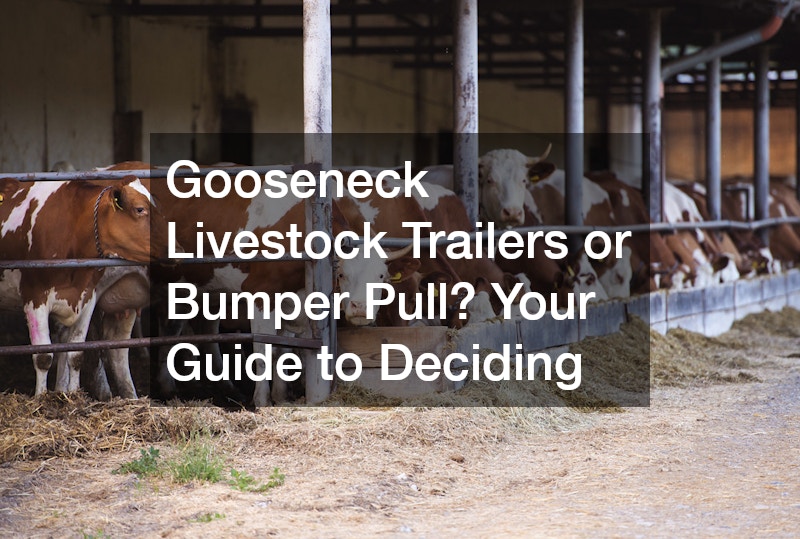
Choosing the right type of livestock trailer is an important decision for ranchers and farmers. Understanding the differences between gooseneck and bumper pull trailers can help you make an informed decision that suits your needs. Both options have their unique advantages and considerations, making it crucial to evaluate which will best accommodate your specific livestock transportation requirements.
What Are the Key Differences Between Gooseneck and Bumper Pull Trailers?
Design and Structure
Gooseneck trailers are characterized by their long hitch, which attaches over the rear axle in the bed of a pickup truck. This design offers increased stability and enhanced weight distribution, crucial for safely transporting larger loads.
On the other hand, bumper pull trailers attach to a standard rear hitch on a vehicle, making them more maneuverable for tight spaces but often less stable when carrying heavy loads.
The structural design of gooseneck trailers typically allows for a higher weight capacity, enabling them to carry larger or more livestock. This is especially beneficial for transporting heavy and bulky animals such as cattle or horses over long distances. In contrast, bumper pull trailers may have more limitations in terms of weight and size, commonly suited for lighter animals or shorter transport distances.
Another notable difference in design is that gooseneck trailers are generally longer, which can provide additional storage space and living quarters for extended travels. This is advantageous for those who require extra amenities or need space for feeding or resting animals during long hauls. On the contrary, the more compact size of bumper pull trailers offers easier storage solutions and is more practical for those who frequently have to maneuver in confined environments.
Towing Mechanics
The towing mechanics of each trailer type significantly affect their handling and ease of driving. Gooseneck trailers, with their over-bed hitch design, provide a tighter turning radius, making cornering smoother and more controlled. This enhanced maneuverability is crucial when navigating through rugged terrains or making sharp turns on farm properties.
Conversely, bumper pull trailers exert more sway at higher speeds due to their hitch point being further from the vehicle’s rear axle. This can lead to less stability during highway travel, particularly in crosswinds or adverse weather conditions. Drivers must ensure their vehicle is properly equipped with sway control bars to mitigate these issues and ensure safer travels.
When considering required vehicle specifications for towing, a gooseneck trailer generally demands a heavier and more powerful pickup truck due to the heavier loads they carry. In contrast, bumper pull trailers are often compatible with a wider range of vehicles, including SUVs and lighter trucks, making them more accessible for those not already owning larger towing vehicles. Understanding these mechanics is crucial for ensuring the compatibility and safety of your towing setup.
Capacity and Size
The capacity and size of the trailer are critical factors that influence transportation efficiency and legislative compliance. Gooseneck trailers usually offer larger dimensions and a higher weight capacity, accommodating more livestock and equipment in a single trip. This larger capacity reduces the number of trips required, translating into potential time and cost savings for ranchers with sizable herds.
Bumper pull trailers, despite their smaller size, can be advantageous in terms of maneuverability and ease of parking. Their compact nature allows for easier navigation in urban or crowded environments, making them suitable for farmers who frequently transport animals to local markets or shows. However, their limited capacity may necessitate more frequent trips, which can be a logistical consideration for those with larger operations.
Regulations regarding road use and weight restrictions may also affect your choice between these two trailer types. Gooseneck trailers, with their larger size, might require specific permits or adherence to stricter regulations when transporting livestock interstate. Conversely, bumper pull trailers may face fewer regulatory hurdles, offering a more straightforward option for those engaging primarily in short-distance or intrastate travel.
Which Type of Livestock Trailer Is Best Suited for My Needs?
Evaluating Livestock Types and Sizes
Analyzing the types and sizes of livestock you plan to transport is fundamental in selecting the appropriate trailer. Gooseneck trailers are often the preferred choice for larger animals like cattle, ensuring they have enough room to move comfortably and reducing the stress during transport. This accommodation can lead to better overall health and condition of the livestock upon arrival.
Small-scale farmers or those transporting smaller animals like goats or sheep might find bumper pull trailers sufficient for their needs. These trailers provide ample space for smaller animals and offer the added benefit of portability and lower cost. Ensuring the trailer is adequately equipped with ventilation and safety features for these animals is crucial, irrespective of the type chosen.
It’s also essential to consider the versatility of the trailer regarding mixed livestock loads. Some gooseneck trailers offer partitions, allowing for the simultaneous transport of different types of animals safely. By contrast, bumper pull trailers may have limited customization options, making them less adaptable for diverse cargo requirements.
Choosing between bumper pull and gooseneck livestock trailers depend on various factors, including your livestock’s needs, travel frequency, and vehicle compatibility. Gooseneck trailers offer greater stability, capacity, and potentially higher resale value, making them suitable for extensive travel and larger operations. Conversely, bumper pull trailers provide an affordable, flexible solution for smaller loads and shorter distances, proving their practicality for many farmers and ranchers. Carefully weighing these considerations will help ensure that your choice aligns with your operational needs and budget, whether you’re managing long-haul trips or local transportation.
.






